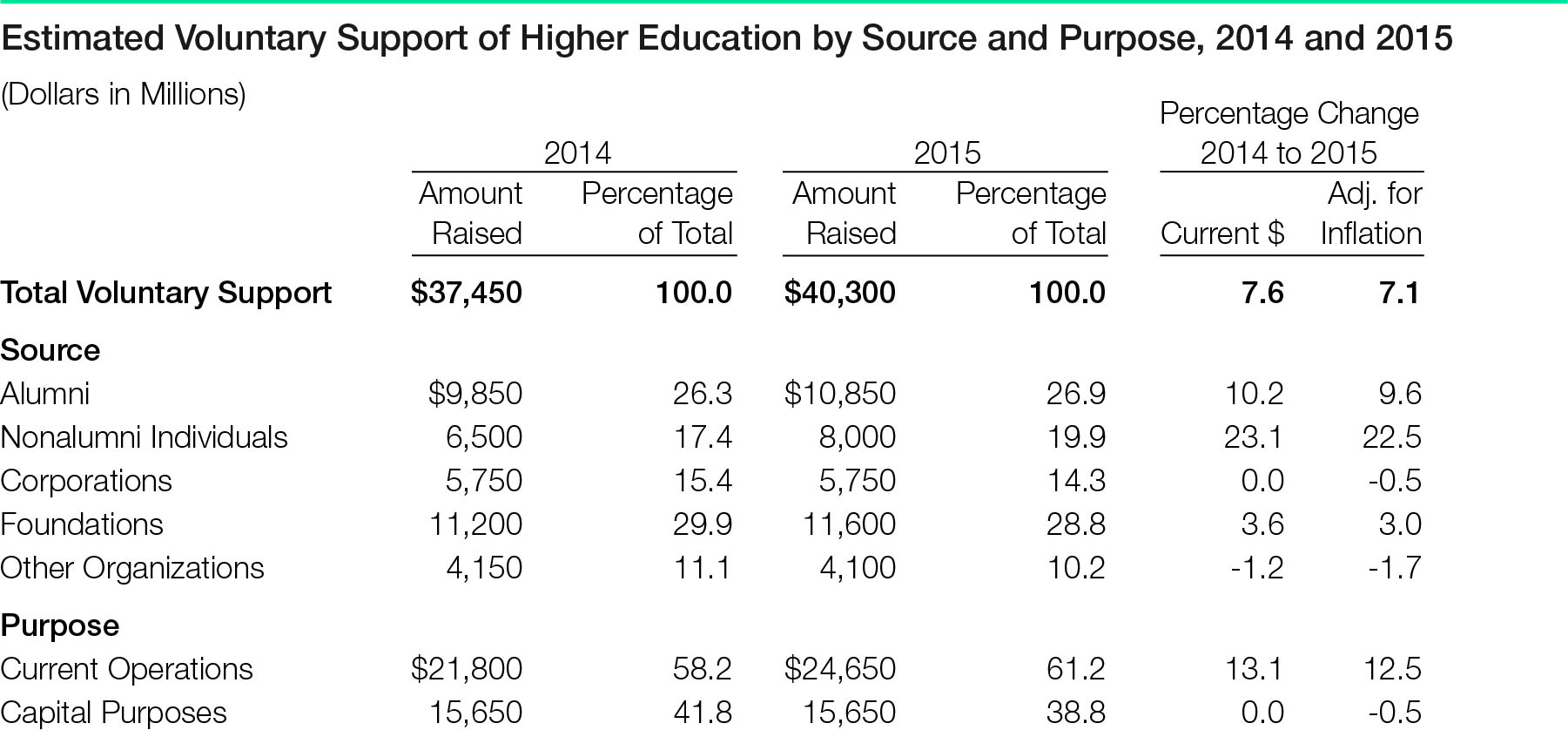You have /5 articles left.
Sign up for a free account or log in.
College endowments may have grown last year by the smallest amount since 2012, as reported elsewhere on this site today, but institutions got some good financial news in the 2015 fiscal year: charitable contributions to colleges and universities rose to a record level, $40.3 billion, the Council for Aid to Education reports in its annual Voluntary Support of Education survey.
Even so, a small and exclusive coterie of institutions is disproportionately benefiting from donors' largesse. The top 17 colleges and universities -- less than 1 percent of the total universe of about 3,900 institutions -- accounted for more than a quarter of the contributions, $10.42 billion. And 60 colleges and universities, under 2 percent of all institutions, received $20.15 billion, half of the total.
The wealth gap in higher education is not a new story, by any means, but it is being fed, not closed, by the behavior of major donors.
The 2015 fiscal year brought at least eight gifts of $100 million or more, up from five the year before, and the eight went to four institutions: Stanford University (four nine-figure gifts, valued at a combined $819 million), Northwestern University (two totaling $201 million), Princeton University (one gift of $293.3 million) and the University of California at San Francisco (one donation of $124.8 million). Those gifts totaled $1.44 billion, nearly half the amount taken in by the 490 surveyed colleges that raised the least, according to the council.
Gauging Giving
The Council for Aid to Education's study is one of a handful of annual reports (along with today's on endowments, last week's on state support for higher education, and some others) that provide a baseline sense of the state of higher education finances. The survey drew fund-raising information from 983 institutions, and it extrapolates from those results to estimate total giving for 3,900 colleges and universities.
The 7.6 percent rise revealed for 2015 by the council's survey, which followed a 10.8 percent gain from 2013 to 2014, was driven largely by giving from individuals (alumni and not), which increased sharply. Donations from foundations and corporations, meanwhile, were either modest or flat, as seen in the table below.
Continuing a trend of recent years, the amount of money donated by alumni rose sharply, by 10.2 percent, to $10.85 billion, but the proportion of alumni who contributed fell to 8.4 percent, from 8.6 percent. (It was 11.7 percent in 2007.)
Ann E. Kaplan, who directs the survey, attributed the decline mostly to the fact that digital and other technologies are helping colleges track down more alumni. "Participation will only increase if the number of donors rises more than the number of located alumni," Kaplan said in a news release. "This is unlikely in a technological age in which individuals may have multiple means of contact that make them easy to locate. Finding an address is much simpler than cultivating a relationship that leads to a contribution."
Giving by nonalumni individuals (donors, parents, etc.) rose by more than any other category, 23.1 percent.
Donations for current operations (as opposed to capital purposes) rose by 13.1 percent in fiscal 2015, while funds for endowments, facilities and other purposes were flat. The study attributes the latter result to the fact that there was a huge -- 23.3 percent -- rise the previous year (fiscal 2014) in gifts to restricted endowments, which is the largest category of capital purposes. That kind of donation tends to track the stock market, which was stronger in 2014 than in 2015.
Seeking Scholarship Dollars
Virtually every college president is vowing to raise more money for student financial aid, as competition for students increases, other forms of revenue wither at many institutions and politicians and policy makers pressure colleges and universities to enroll more students from low-income backgrounds. But the CAE study doesn't offer a lot of evidence that fund-raising will be the panacea the presidents hope.
Data supplied by CAE's Kaplan show that the amount of money dedicated for financial aid is large -- accounting for about 39 percent of all restricted endowment funds raised and 9.5 percent of donations received for current operations in 2015. But the proportion of raised funds that are committed for financial aid has held relatively steady for the last two decades.
Colleges can obviously spend more from their nonrestricted endowment funds and redirect operating funds to increase spending on financial aid, but that would mean that they might have to shortchange other priorities, which can anger other constituents.
They may feel pressure to do so if Congress again cranks up pressure on wealthy institutions as it did in the mid-2000s; a New York congressman recently proposed legislation to require colleges with endowments of larger than $1 billion to spend at least 25 percent of endowment income on financial aid or risk losing their tax-exempt status. But college leaders probably shouldn't expect fund-raising to be their answer.
"There is no historical evidence," said Kaplan, that "philanthropy is meant to be income distributive."
| 1. | Stanford University | $1,625,035,715 |
| 2. | Harvard University | $1,045,872,364 |
| 3. | University of Southern California | $653,025,324 |
| 4. | University of California at San Francisco | $608,579,603 |
| 5. | Cornell University | $590,641,234 |
| 6. | Johns Hopkins University | $582,675,454 |
| 7. | Columbia University | $552,682,100 |
| 8. | Princeton University | $549,839,705 |
| 9. | Northwestern University | $536,831,345 |
| 10. | University of Pennsylvania | $517,197,984 |
| 11. | University of California at Los Angeles | $473,205,186 |
| 12. | Duke University | $472,008,266 |
| 13. | University of Washington | $447,020,543 |
| 14. | University of Chicago | $443,792,362 |
| 15. | Yale University | $440,806,570 |
| 16. | New York University | $439,662,170 |
| 17. | Massachusetts Institute of Technology | $439,403,673 |
| 18. | University of Michigan | $394,310,140 |
| 19. | University of Notre Dame | $379,869,442 |
| 20. | University of California at Berkeley | $366,115,961 |
| 21. | Ohio State University | $359,797,648 |
| 22. | Indiana University | $359,319,004 |
| 23. | University of Minnesota | $357,861,275 |
| 24. | University of Wisconsin at Madison | $330,454,447 |
| 25. | University of Colorado at Boulder | $322,654,968 |






